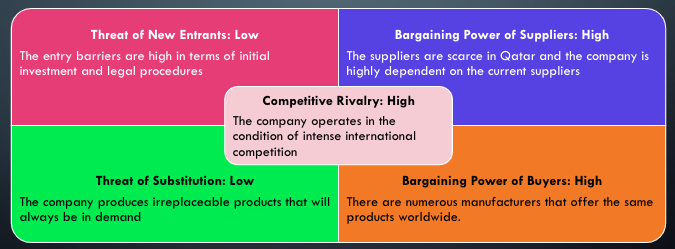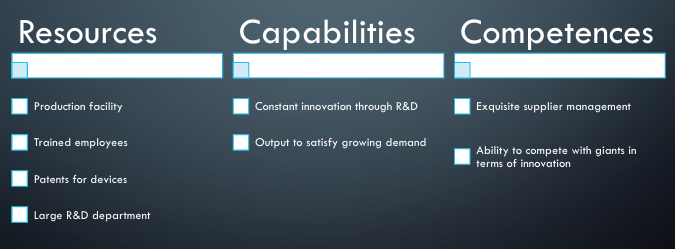Company Overview
QG Medical Devices is a leading manufacturer of Medical Devices in the Middle East. It was established in 2000 in Doha, and it has been growing steadily since then. The key products the company produces are injection-related equipment. However, the company also distributes medical equipment and furniture of the highest quality.
Mission and Vision
Vision:
- “To revolutionize international patient care safety standards around the world” (Qatari German Medical Devices, 2021, p. 8)
Mission:
- “To become a leading medical devices manufacturer in the healthcare industry worldwide by continuing to introduce innovative and superior medical devices which guarantee better patient care” (Qatari German Medical Devices, 2021, p. 9)
The analysis of the statements revealed that the company’s strategy is based on two basic vectors. First, the company sees patient safety as a top priority of the business. Second, the company emphasizes its focus on R&D and innovation. However, it should be mentioned that the company sees the primary purpose of innovation as improving patient safety.
Timeline
QG Medical Devices was established in 2000. It was developing gradually until 2012 when the company decided to adopt the vision of becoming a global company. This vision was adopted in accordance with Qatar National Vision 2030. The same year, the company started to report annual losses. In 2017, due to the international conflict and embargo of Qatar, the company reported the highest loss in its history. Even though QG Medical Devices was able to mitigate the consequences of the blockade in 2018, the losses continued.
In 2020, the pandemic increased the demand for medical devices. Moreover, QG Medical Devices started to produce face masks, which increased sales significantly. As a result, the company reported annual income in 2020 for the first time in eight years. In 2021, the company declared an even higher income.
Possible Problems
Two possible problems were identified. First, the political situation in the world is currently unstable due to the war in Ukraine and the consequences of Qatar’s blockade. Such instability can affect the supply chain of the company and the demand for products.
External Analysis
PESTEL Framework
A comprehensive PESTEL analysis is provided through an assessment of six types of factors affecting the industry, including political, economic, social, technological, environmental, and legal. The crucial external factors that affect the company are political and technological, as the company is forced to continue investing in innovation to keep up with the competitors and have a contingency plan in case of political situation affects supply chains or demand.
Political:
- War in Ukraine.
- Trade wars.
Economic:
- Economic instability due to COVID-19 and war in Ukraine.
- Rising medical devices market.
Social:
- Growing environmental concern.
- Growing health concern.
Technological:
- Technological advances of competitors in medical equipment.
Environmental:
- Push for environmental sustainability.
Legal:
- Employment laws alignment.
Porter’s Five Forces

The analysis revealed that the key threats to the company are the competitive rivalry and bargaining powers of suppliers and buyers.
Competitive Environment
The analysis of the competitive environment revealed that the company operates in an oligopoly. Under Oligopoly, a firm can earn super-normal profits in the long run as there are barriers to entry like patents, licenses, control over crucial raw materials, etc. These barriers prevent the entry of new firms into the industry.
Firms try to avoid price competition due to the fear of price wars in oligopolies and hence depend on non-price methods like advertising, after-sales services, warranties, etc. This ensures that firms can influence demand and build brand recognition.
Internal Analysis
Resources, Capabilities, and Competencies

The analysis revealed that even though QG Medical Devices is an SME, it has large resources, valuable capabilities, and unique competencies it can use to compete in the global arena.
VRIO Framework

The results of the internal analysis of the company using the VRIO framework revealed that the company possesses resources and capabilities that are valuable, rare, costly to imitate, and organized.
Value Chain
The value chain of the company was conducted to consider how each step adds or subtracts value from the final product or service.
Company Performance/Competitive Advantage
The company’s profitability grew from -10.4 million QR in 2018 to 1.2 million QR in 2021 (Qatari German Medical Devices, 2021). Profitability is below the main competitors (Mordor Intelligence, 2021). The company has a small market share.
Trends
The research revealed that the market is expected to grow in the following five years at a stable pace. The primary driving forces of the market are the COVID-19 pandemic and aging populations. At the same time, the retraining force is the growing cost of the devices.

SWOT Analysis

Diagnosis
The results of the strategic analysis revealed several problems. On the one hand, the opportunity of growing demand was not used. In particular, the company did not plan any expansions to address the growing needs. However, this may be adequate, as the current facility is large enough to satisfy the growing demand. The increased demand was used to stabilize the financial situation.
On the other hand, the company is highly dependent on a limited number of suppliers, which increases its power. Additionally, the company operates in a situation of increased political and economic instability, which may disrupt the supply chain.
Solution
The solution for the identified problem was to increase the number of suppliers. This will address three issues identified during the analysis. First, it will decrease the bargaining power of suppliers. Second, it will address the possible problems of supply chain disruption. Finally, diversification of products can decrease the cost of production, which will increase the profit margin and improve financial stability.
Implementation Plan
Activities:
- Conduct research to find the best suppliers
- Partner with new suppliers
- Create a new supply chain with a contingency plan in case of disruptions
- Negotiate new prices with suppliers
Timeline:
- The activities will take six months
Financial Feasibility:
- No capital investments are required.
SMART Objectives:
- Increase the number of suppliers by 30% in six months
- Decrease the prices of supplies by 5% in six months
- Create a contingency plan for supply chain disruptions in six months.
Sources
Fortune Business Insights (2021) Medical devices market.
Dreamstime (no date) Oligopoly concept with icon[Image].
Qatari German Medical Devices (2021) Annual report 2020.
Qatari German Medical Devices (no date) About QG.
Mordor Intelligence (2021). Medical devices market – Growth, trends, covid-19 impact, and forecast (2022 – 2027).